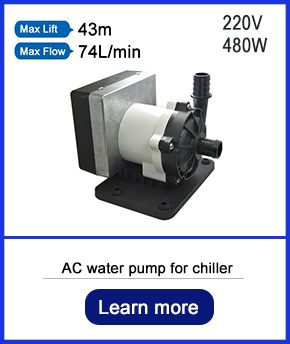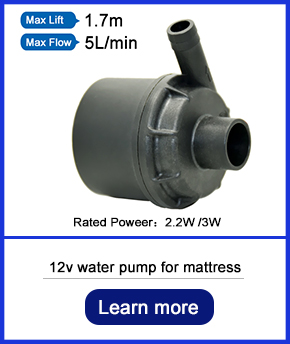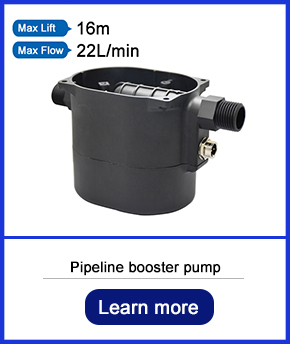Small water pumps are widely used in various industries. Understanding the small water pump types and their working principle is essential for making the right choice. A small water pump is a common device mainly used to transport water from one place to another.The working principle of a small water pump is to drive the impeller to rotate through an electric motor, generating centrifugal force, which sucks water into the pump body and then discharges it through the outlet.
 |  |  |
The main components of a small water pump include the motor, pump body, impeller, seals, and water outlet. The motor is the power source of the small water pump, and it drives the impeller to rotate through the electrical energy provided by the power supply. The pump body is the main part of a small water pump, usually made of materials such as cast iron or stainless steel, which has good corrosion resistance and wear resistance. The impeller is the core component of a small water pump, which generates centrifugal force through rotation and sucks water into the pump body. The seal is a key component of a small water pump, mainly used to prevent water leakage. The water outlet is the outlet of a small water pump, which discharges the water inside the pump body.
The working principle of a small water pump is based on centrifugal force. When the motor starts, the impeller begins to rotate and generate centrifugal force. The centrifugal force sucks water into the pump body and then discharges it through the outlet. Throughout the entire process, the seal played a crucial role in preventing water leakage from the pump and ensuring its normal operation.
Small water pump has a wide range of applications, which can be used in household, agriculture, industry and other fields. In households, small water pumps are usually used for drainage, irrigation, water supply, and other purposes. In agriculture, small pumps can be used for irrigation, drainage, spray and other aspects. In industry, small water pumps can be used for conveying liquid, circulating cooling and other aspects.
Small water pump is a very practical type of water pump. Its working principle is based on centrifugal force. The motor drives the impeller to rotate, sucks water into the pump body, and then discharges water through the outlet. Small water pump has a wide range of applications, and can be used in household, agricultural, industrial and other fields.
Small Water Pump Types
1. Centrifugal Pumps
Centrifugal pumps are among the most common types of small water pumps. They work by using centrifugal force to move water. When the pump is activated, the impeller (a rotating component) spins, creating a vacuum that draws water into the pump. The water is then pushed out through the discharge port due to the centrifugal force generated by the spinning impeller. These pumps are ideal for applications that require a high flow rate but relatively low pressure. They commonly are used in residential settings for tasks such as circulating water in heating systems, transferring water from wells to storage tanks, or providing water supply to homes. Centrifugal pumps are also widely used in small-scale agricultural irrigation systems, where they can efficiently distribute water to crops over a large area.
2. Submersible Pumps
As the name suggests, submersible pumps are designed to operate underwater. They are fully sealed to prevent water from entering the motor. The motor is located at the bottom of the pump, which allows it to be submerged directly into the water source. This type of pump is highly efficient because it does not need to overcome the suction lift (the distance the pump needs to lift the water from the source to the pump inlet) that other pumps face. Submersible pumps are commonly used in wells to extract groundwater. They are also used in aquariums and ponds to circulate water and maintain water quality. In addition, they are utilized in flood control systems to pump out excess water from basements or low-lying areas during heavy rainfall. The compact design and ability to operate underwater make submersible pumps a convenient choice for many applications.
3. Diaphragm Pumps
Diaphragm pumps operate using a flexible diaphragm that moves back and forth to create pressure and move water. When the diaphragm moves inward, it creates a vacuum that draws water into the pump chamber. As the diaphragm outward moves, it increases the pressure, forcing the water out of the pump. One of the key advantages of diaphragm pumps is their ability to handle small amounts of water with high precision. They are also capable of pumping water that contains small particles or debris without clogging easily. This makes them suitable for applications such as laboratory water transfer, where precise control of water volume is required. Diaphragm pumps are also used in some small industrial-scale processes, such as transferring chemicals or solutions that may be corrosive or abrasive to other types of pumps.
4. Jet Pumps
Jet pumps are a type of centrifugal pump that uses a special nozzle to create a jet of water, which helps to draw additional water into the pump. This makes them particularly effective for applications where the water source is located below the pump, such as in shallow wells. The jet pump uses a portion of the water it pumps to create a vacuum through the nozzle, which then draws more water from the well. Jet pumps are available in two main types: shallow well jet pumps and deep well jet pumps. Shallow well jet pumps are designed for wells with a depth of up to about 25 feet, while deep well jet pumps can handle deeper wells by using a different configuration that includes a jet assembly located down the well. These pumps are commonly used in rural areas to provide water supply to homes and small farms.
5. Vane Pumps
Vane pumps use a series of vanes (thin, flat pieces) that slide in and out of a rotor to create a pumping action. As the rotor turns, the van movees outward against the pump housing, creating sealed chambers that move water from the inlet to the outlet. Vane pumps are known for their smooth operation and ability to handle a wide range of flow rates and pressures. They are often used in applications that require a constant flow of water, such as in small-scale hydraulic systems or in some types of industrial equipment that need a reliable water supply for cooling or lubrication. The compact size and relatively low noise level of vane pumps make them suitable for use in environments where space is limited and noise needs to be minimized.
6. Gear Pumps
Gear pumps use two meshing gears to move water. As the gears rotate, they create a partial vacuum that draws water into the pump. The water is then carried between the teeth of the gears and forced out through the discharge port. Gear pumps are positive displacement pumps, meaning they deliver a fixed amount of water with each rotation of the gears. This makes them highly accurate for applications that require a precise volume of water to be transferred. They are commonly used in small chemical processing plants to transfer viscous fluids or in some types of machinery that require a consistent supply of lubricating fluid. Gear pumps are also used in some small-scale food processing applications, such as pumping syrup or other thick liquids.
Learn more: Working principle of small water pump Application of small water pump in water heater industry Small water pump: the core component of automotive cooling system |
Small Water Pump 12V, small water pump - bunnings, Small water pump for bathroom, Small Water Pump 240V, Small water pump for home, Small water pump price, Best small water pump, small electric water pump - bunnings
Address:No.30, Dapu lndustrial Street, Changping, Dongguan, Guangdong, China
Tel: +86-186 7628 8117